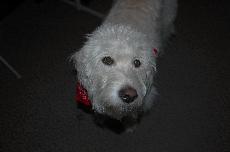Therapy dog, Kasey, a favorite in education department
October 29, 2008
There’s a familiar face in the Wallace hallways these days, but it isn’t that of a professor or a student. The face belongs to Kasey, a shaggy, white labradoodle, She’s become so popular, some joke she should have an office of her own.
Kasey works with her owner Pat Kelley, visiting instructor of education.
Kelley trained Kasey as a therapy dog to work with students with special needs, but Kelley said students can benefit from her as well.
According to Kelley, therapy dogs can sense tension and stress. Often times, having a pet around can help relieve that tension. She said Kasey is particularly calming to students during tests.
Kelley has had dogs for 25 years and has been training dogs for 20. Her passion is to train dogs because comes naturally. Kelley has been working with Kasey since she got her four years ago.
Kasey was 12 weeks old Kelley began training her. Kelley has also trained three other dogs.
“Any dog can be a therapy dog,” Kelley said.
These dogs work in many different environments: with children, in hospitals and with the elderly. They must be able to adapt and be handled roughly in some cases. Ideal therapy dogs are those with agreeable personalities.
“I move naturally to work with dogs,” Kelley said. “I feel that working with dogs brings the world together.”
Students on campus seem to enjoy Kasey as well.
“It is a joy to be greeted by Kasey in the morning. She’s a very sweet dog and really does brighten a morning,” junior Stevie Trevathan said.
Kasey has had an impact on students in the classroom and in their personal lives.
Beyond the classroom, she also helps students with autism, disabilities and illnesses. Some of these activities include visiting elementary schools, nursing homes and hospitals. Kasey even goes to homes of autistic children.
“A lady also spoke to us about her autistic daughter’s relationship with Kasey as a therapeutic dog,” junior Leah Grothe said. “Her daughter was very scared of dogs, but took a quick liking to Kasey. Through Kasey’s example, I was able to create a clear understanding of autism and available treatments.”
Kasey provides a sense of compassion for the sick and for children with disabilities. Kasey always visits by invitation only, this way she’s not disrupting the classroom or other environment.
“Kasey provides some diversity to our classroom, which is great because it meets all of our needs as diverse learners,” Grothe said.
At Simpson, Kasey is included in the classroom only if the students vote on an anonymous questionnaire at the beginning of the course. So far nobody has denied her in the classroom setting.
“If Kasey misses a day of class, students are asking where she is,” Kelley said.
Therapy dogs can provide a relaxing environment for autistic children. Kasey is trained to pin point struggling students. She senses when someone is in need of some attention. By lying by their feet or wanting to be petted she gives the student a sense of comfort,
Trevathan agrees.
“I must admit, having a dog at your feet during a test does make taking the test more relaxing.”












